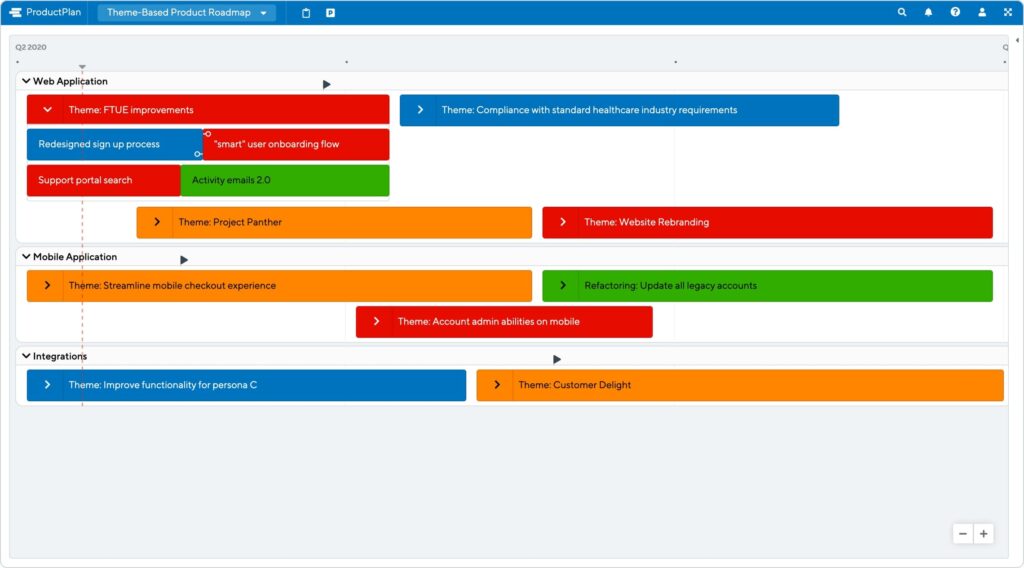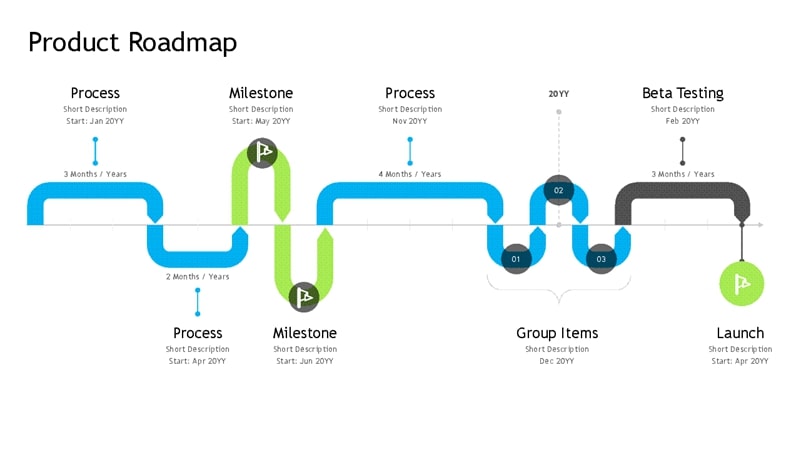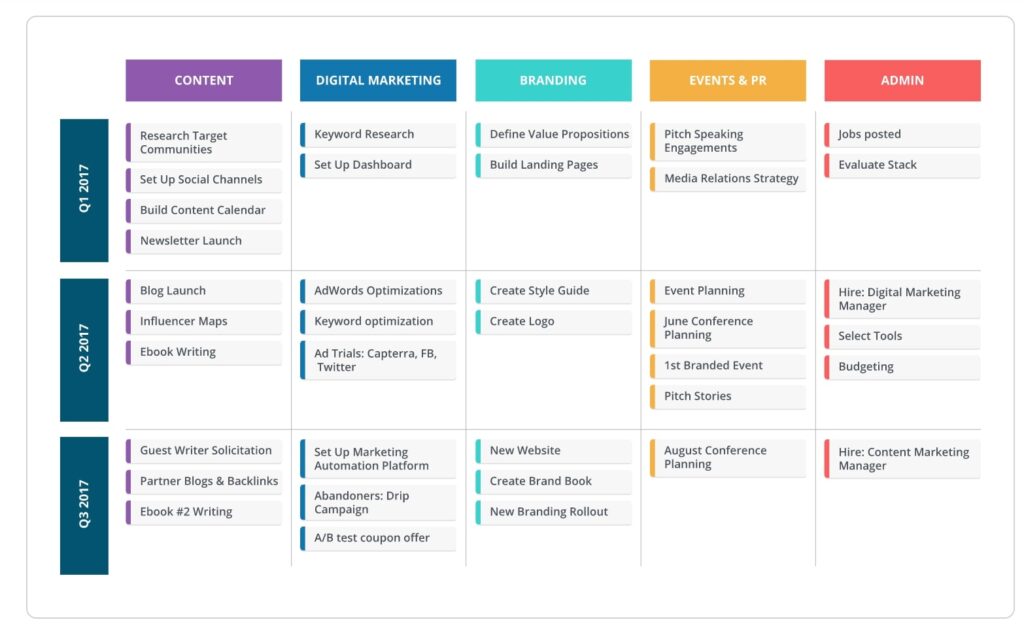Product owners use roadmaps to plan how a product, service, or solution evolves, outlining the development of future functionality, features, or upgrades. Roadmaps serve to communicate and align stakeholders and teams.
In an agile product management environment, the roadmap offers context for the day-to-day workflow of a development or product team. However, the agile nature of the roadmap makes it easy to adjust in response to market changes, release updates, or new functionality from competitors.
Critics of agile development suggest that the long-term planning process is no longer viable. However, this is far from true.
A product roadmap is as essential for an agile team as it is for a traditional development team. It keeps teams focused on the delivery of the product while helping them respond better to shifts in the landscape.
The Agile Product Roadmap
A product roadmap is a plan for how a product, or solution, develops and evolves. Product owners use them to outline future product fixes, functionality, and features while providing release dates.

Credits: Product Plan
Teams use product roadmaps in waterfall project management, whereby the product progresses in a linear manner from beginning to end and results from careful planning throughout.
Agile roadmaps provide context for an Agile team’s everyday work. They facilitate changes in the product and competitive landscape. Agile roadmaps also allow more than one team to work on a single product roadmap in concurrence.
Creating the Agile Roadmapping Process
Owners take into account several factors when creating agile product roadmaps. Product owners must understand market forces, engineering constraints, and value propositions to help them make a practical, goal-oriented product roadmap while ensuring the product vision does not get compromised.
Agile product roadmaps consist of two key features, initiatives, and timelines. Initiatives are the deliverable tasks that make up the product strategy, and timelines show the amount of time allowed to deliver each task and measure critical milestones in the product delivery.

Credits: Medium
When creating a goal-oriented roadmap template, make your roadmap measurable. Enable a key performance indicator for each goal. This helps with reviews by allowing the assessment of tangible metrics.
When setting the metrics, make sure that each measurable is a realistic target. For example, if selecting a due date for completing a task, ensure it is achievable.
Sharing the Agile Product Roadmap
Once you’ve created a roadmap, you must then share it with everyone involved in developing and producing the product. Each team member must understand the direction and product vision, so the roadmap must tell a coherent story that gets the buy-in of all colleagues.
The easiest way to share an agile product roadmap is through a collaboration tool rather than a PowePoint document or spreadsheet. If you end up doing the latter, you have to then email the roadmap to the entire team whenever you update the roadmap.

Credits: Road Munk
This means that its success is reliant on them making updates and, most important, circulating the amended roadmap by email to the rest of the team after you’ve implemented those changes.
Using a collaborative tool for an agile product roadmap removes the reliance on humans to share updates by automating notifications to all colleagues involved in a project every time you make a change.
This means that all key stakeholders are kept up-to-date on the product roadmap’s progress and made aware of any adjustments that affect their workstream.
Adding Initiatives to Roadmaps
There are several questions to consider before adding an initiative to product roadmaps to make sure they are adding value.
- What are the relative priorities of each initiative? Understand what dependencies each initiative has on other initiatives or other teams.
- When do we work on each initiative? Consider whether there are specific due dates that need meeting.
- Which teams must work on which initiative? Make sure each team has the capacity, resources, and time to complete the requirements.
- Are agile teams stable? If not, consider how to reorganize teams to meet the project’s immediate needs.
Using the Agile Product Roadmap
There’s little to gain in asking people to work on something in any work environment if they don’t understand why they’re doing the task. It is essential to link the team’s work back to the roadmap to provide them with context.
One way of achieving this is to break initiatives down into epics (large bodies of work) and then delving further to create requirements and user stories. These roadmap features allow product managers and their teams to make short-term decisions that don’t hurt longer-term work.
The ability to take a step back when faced with a critical decision, discuss, research, and consider options, is at the root of an agile product roadmap and its effectiveness. Teams evolve new features, fixes, and upgrades as the project progresses as they learn about the product and market.
Product managers must be aware of some common traps when using and updating their internal roadmap.
For example, all decisions and changes to the agile roadmap must take into account the future planning and the longer-term impact of the adjustment on the product’s development.
In conjunction with that, the agile roadmap is a critical communication tool. You must communicate all changes to the rest of the business to avoid nasty surprises for other teams further down the line.
Other potential pitfalls include updating the roadmaps too often (or not often enough) and becoming too detailed with requirements that weigh down the plan.
How and When to Evolve Your Agile Product Roadmap
There are risks attached to running product roadmaps in agile environments, just as in traditional roadmaps.
Waterfall roadmaps require team members to invest in the business objectives and commit to the roadmap. In some cases, they become too close to the roadmap and, when problems arise, cannot take the right decision because of the amount of work they need to undo.
The three main risks for agile development teams to understand are:
- There is a loss of confidence in the leadership’s ability to make the right strategic decision if they update the roadmap too often.
- If you don’t update the roadmap often enough, you miss key milestones resulting in late arrival on the market. This causes the risk of a knock-on effect on sales and company reputation.
- Teams get bogged down with too many details and lose sight of the bigger picture. While they achieve short-term results, they forget the long-term overall business goals.
Maintaining the roadmap’s focus balanced on both short-term value-add tactics and the strategic long-term business goals keeps product teams from going stale and retains their focus on the most crucial features of the roadmap.
An excellent way of achieving this is to review and adjust the agile roadmap on a regular basis. For example, holding a review every month or quarter. This enables teams to share progress, address customer feedback and assess the ongoing suitability of each existing initiative.
Share any changes with internal customers and key stakeholders, and involve all agile teams involved in the product delivery.
With careful management, agile roadmaps measure progress on a product’s route to market in an organization of any size.